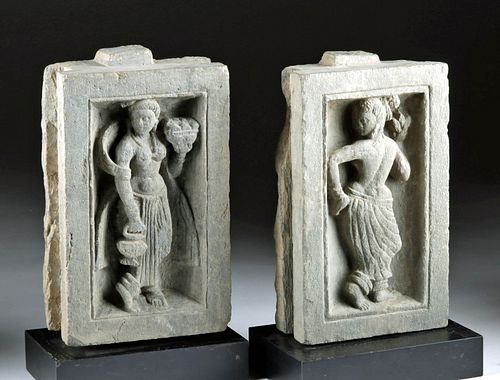Gandharan Schist Panels Female Dancers, ex-Sotheby's
Lot 126
About Seller
Artemis Gallery
686 S Taylor Ave, Ste 106
Louisville, CO 80027
United States
Selling antiquities, ancient and ethnographic art online since 1993, Artemis Gallery specializes in Classical Antiquities (Egyptian, Greek, Roman, Near Eastern), Asian, Pre-Columbian, African / Tribal / Oceanographic art. Our extensive inventory includes pottery, stone, metal, wood, glass and textil...Read more
Estimate:
$4,000 - $6,000
Absentee vs Live bid
Two ways to bid:
- Leave a max absentee bid and the platform will bid on your behalf up to your maximum bid during the live auction.
- Bid live during the auction and your bids will be submitted real-time to the auctioneer.
Bid Increments
| Price | Bid Increment |
|---|---|
| $0 | $25 |
| $300 | $50 |
| $1,000 | $100 |
| $2,000 | $250 |
| $5,000 | $500 |
| $10,000 | $1,000 |
| $20,000 | $2,500 |
| $50,000 | $5,000 |
| $100,000 | $10,000 |
| $200,000 | $20,000 |
About Auction
By Artemis Gallery
Oct 7, 2021
Set Reminder
2021-10-07 10:00:00
2021-10-07 10:00:00
America/New_York
Bidsquare
Bidsquare : Exceptional Antiquities Ethnographic Fine Art
https://www.bidsquare.com/auctions/artemis-gallery/exceptional-antiquities-ethnographic-fine-art-7537
Museum-worthy examples of Egyptian, Greek, Roman, Etruscan, Near Eastern, Far East / Asian, Pre-Columbian, African / Tribal, Oceanic, Native American, Spanish Colonial, Fossils, Ancient Jewelry, Fine / Visual Arts, so much more! Artemis Gallery info@artemisgallery.com
Museum-worthy examples of Egyptian, Greek, Roman, Etruscan, Near Eastern, Far East / Asian, Pre-Columbian, African / Tribal, Oceanic, Native American, Spanish Colonial, Fossils, Ancient Jewelry, Fine / Visual Arts, so much more! Artemis Gallery info@artemisgallery.com
- Lot Description
Central Asia, Pakistan and Afghanistan, Gandharan Empire, ca. 200 BCE to 100 CE. A pair of fantastic, sensual female dancers, each in high relief in a deep rectangular panel. One's body is turned away from the viewer, with her head twisted around to peer in profile over one shoulder. She wears a floor-length skirt that sits low on her hips, revealing her beautiful hourglass figure. The side of one breast is just visible. Her hair is pulled up in a bun, with a strand hanging down the side of her face. One hand rests on her hip, the other is raised and holding a lotus flower. Bangles are at her wrists and ankles. Size of each: 6.05" W x 10.35" H (15.4 cm x 26.3 cm); 12.15" H (30.9 cm) on included custom stand.
The other panel features a woman who faces forward, holding a basket in one hand and a small bag with a large handle in the other. She, too, is nude above her hips, and wears a floor length skirt. She stands with her legs crossed at the ankle and has a diaphanous band of cloth wrapped around her arms and back; the artist has carved it so that it appears to flow in a breeze. She wears bangles at her wrists and ankles, a large necklace whose pendants rest against her large breasts, and huge hanging earrings. The form of both women here is inspired by a youthful female divinity known as a yakshi, a fertility figure whose touch was said to make trees bloom.
Gandharans are famous for their schist carvings. Vast monastic institutions like those at Takht-i-Bahi, Sahri-Bahlol, Jamal Garhi, Ranigat, and Thareli were decorated by skilled artisans with carved representations of important figures, religious scenes, and artistic dedications. During this time, Gandhara was exceptionally wealthy, profiting from trade along the Silk Road; patrons had resources to spend on the arts, creating a flowering of artwork. Women, however, are rare subjects in Gandharan art. Where they are seen, they are often dancers, musicians, or otherwise portrayed as performers. Some of this artwork is thought to be inspired by Dionysus and the Greco-Roman influence on Gandharan art and culture. Others, however, tell the story of Buddha, with dancing women interpreted as heavenly apsaras, female spirits of the skies and waters in Buddhist and Hindu culture.
Published in "Across Time #110", Fortuna Fie Arts, Ltd., 2005.
Provenance: private East Coast, USA collection; ex-Sotheby's Indian Sale, New York, USA, 9-20-2005, Lot 47
All items legal to buy/sell under U.S. Statute covering cultural patrimony Code 2600, CHAPTER 14, and are guaranteed to be as described or your money back.
A Certificate of Authenticity will accompany all winning bids.
PLEASE NOTE: Due to recent increases of shipments being seized by Australian & German customs (even for items with pre-UNESCO provenance), we will no longer ship most antiquities and ancient Chinese art to Australia & Germany. For categories of items that are acceptable to ship to Australia or Germany, please contact us directly or work with your local customs brokerage firm.
Display stands not described as included/custom in the item description are for photography purposes only and will not be included with the item upon shipping.
#142284Both have light wear commensurate with age but are overall very nicely preserved. This includes some small losses on the surface, but nearly all details are present.Condition
- Shipping Info
-
All shipping is handled in-house for your convenience. Your invoice from Artemis Gallery will include shipping calculation instructions. If in doubt, please inquire BEFORE bidding for estimated shipping costs for individual items.
-
- Buyer's Premium



 EUR
EUR CAD
CAD AUD
AUD GBP
GBP MXN
MXN HKD
HKD CNY
CNY MYR
MYR SEK
SEK SGD
SGD CHF
CHF THB
THB














